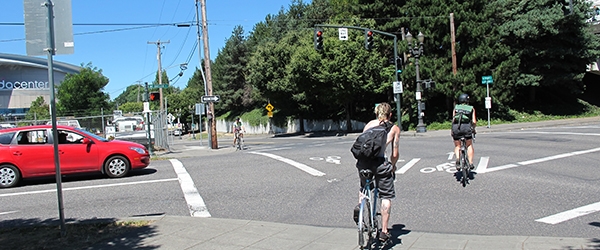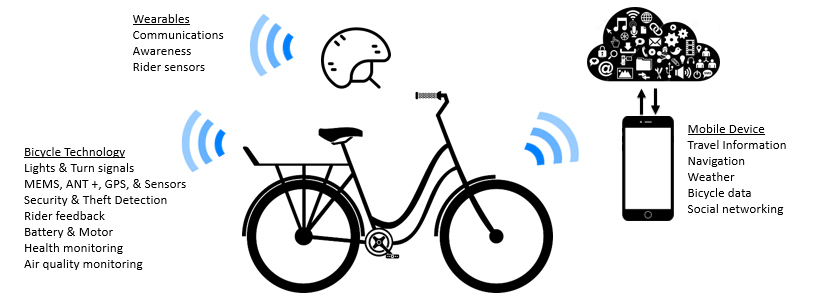If Bikes Could Talk: Would Connected Vehicle Tech Get More People Riding?

What if your bicycle could warn you that a car is coming from a side street you can't see? Or let you know that your front tire is getting a little low, or that you're approaching a pothole that wasn't there yesterday? A NITC research project led by John MacArthur of Portland State University explores how connected vehicle (CV) technologies could encourage an increase in bicycling. As CV technology moves forward in the rest of the transportation system—with buses and connected streetcars requesting early green lights from the traffic signals, and cars chatting with each other about their locations and trajectories—there may be perks in this growing interconnected system that can benefit bicyclists, too. Some riders might argue that the bike "ain't broke," but the fact is, there is potential in new technology that may enable people to ride bikes who currently aren't, for a wide variety of reasons.
The final report, released this month, reviews existing and prototyped "connected bicycle" technologies and discusses the potential of each technology to mitigate known barriers to cycling. It provides context into the societal needs of bicycling and current strategies to increase the bicycle mode share, the potential of bicycle-to-vehicle and bicycle-to-infrastructure technologies, and the future needs and expected pathways of connected bicycle technologies.
THE POTENTIAL FOR CONNECTED BICYCLES
Since the early 2010s, the U.S. Department of Transportation (U.S. DOT) has been prototyping and assessing CV research and development activities. These efforts have led to more than three dozen CV applications. After a comprehensive review, the research team identified those that could potentially benefit current and future bicyclists. They found that those technologies could be grouped into two main categories: situational sensing and two-way communication.
SITUATIONAL SENSING

Situational sensing encompasses a myriad of technologies, many of which are equipped with sensors and modules (e.g. accelerometers, gyroscopes, GPS chips, light and motion sensors, etc.) which collect data that can be shared to the web, with the bicyclist through a smartphone, and/or other integrated devices. Situational sensing technology can collect data on:
- Trip information (e.g. route, speed and distance)
- Bicyclist information (e.g. heart rate, blood pressure, and endurance)
- Bicycle status information (e.g. tire pressure and battery life)
- Environmental information (e.g. potholes, weather, topography, and traffic)
Safety Applications
Several of these CV technologies can detect and alert bicyclists of approaching vehicles, or direct them away from potentially dangerous intersections and routes. Some can detect a crash using data collected from an onboard accelerometer. When devices like the Ellipse smart lock, Garmin Edge, The BikeSpike, or Cosmo detect that a crash has occurred, they send a message to the bicyclist’s smartphone asking whether or not they wish to have an alert with their location sent to their emergency contacts.
The final report includes a table with the full list of barriers to cycling and connected applications.
Physical Applications
Many individuals face physical limitations that may deter them from bicycling, such as health conditions, living in a hilly area, and living far from where they work and play. E-bikes provide a unique opportunity to enhance the development of connected bicycles because they already come equipped with a battery, which can serve as a platform for integrating sensor technologies and GPS. These features and the crash detection technologies discussed above can be especially important for individuals facing health barriers, by providing pedal assistance and/or additional incident awareness.
Navigation & Mobility Applications
What if your bike could tell you the fastest route, shortest route, most popular route, safest route, or even the quietest route? These features are essential to increasing the total number of trips taken by bicycle, because not knowing how long a trip will take – or the quickest and safest way to get to a destination – can be a significant deterrent for choosing to travel by bicycle. Bicyclists are also sensitive to route obstructions such as congestion, roadwork/construction, and ground conditions like potholes, icy roads or debris. The detection of these hazards allows bicyclists to reroute their trip and avoid delay.
Other Applications
Connected bicycle technologies can also help with security, real-time maintenance, and measuring and tracking personal performance metrics. Friendly, metrics-driven competitions such as Portland, Oregon’s "Bike More Challenge" are commonly used as a strategy to increase rates of bicycling. These devices also make it easier for individuals with varying health conditions to monitor important metrics, which could permit the prevention of a health-related incident while bicycling.
TWO-WAY COMMUNICATION

Two-way communications between road users, or between a road user and the infrastructure, are another type of CV technology. The messages are used to detect potential dangers imposed by traffic, terrain, or weather. The data generated through the process of two-way communication can help cities identify important traffic trends (such as collision hot spots, travel speeds, road user behavior, etc.) and support smart city initiatives. These data would contribute significantly to the information collected by existing technologies such as traffic monitoring sensors.
Safety Applications
Two-way communication between between bicyclists and other road users would provide bicyclists with many of the same safety benefits projected for CV operators. Bicyclists would be able to alert other road users of their presence and receive warnings regarding potential collisions, dangerous intersections and encroaching vehicles. These connected bicycle applications would greatly improve user awareness and reduce the likelihood of vehicle-bicycle collisions, which could encourage less confident bicyclists to ride.
Navigation & Mobility Applications
Bicycle-to-infrastructure communication could provide bicyclists with real-time information regarding collisions, weather, recommended speeds, and road conditions. This information could be used to generate optimal routes and to avoid potential delays. Furthermore, bike-to-infrastructure communication would permit signal prioritization for cyclists, increasing their sense of inclusion in the roadway system. Improved travel time and reduced physical effort would help overcome two significant deterrents to bicycling, especially for commute purposes.
CONCLUSIONS
CV technology offers opportunities for growth in technology, innovation, and the overall bicycling mode share. The report authors believe that bicycle manufacturing companies, bicycle advocates, and active transportation planners should be included in the connected vehicle conversations taking place at all scales of government. As CV technologies advance, these groups have a unique opportunity to explore new concepts and encourage the integration of connected bicycles.
This research was funded by the National Institute for Transportation and Communities, with additional support from the Oregon Department of Transportation, Intel, and Portland State University.
RELATED RESEARCH
To learn more about this and other TREC research, sign up for our monthly research newsletter.
- Connected Streetcar Project
- The E-Bike Potential: How E-Bikes Can Improve Sustainable Transportation
- V2X: Bringing Bikes into the Mix
The Transportation Research and Education Center (TREC) at Portland State University is home to the National Institute for Transportation and Communities (NITC), the Initiative for Bicycle and Pedestrian Innovation (IBPI), and other transportation programs. TREC produces research and tools for transportation decision makers, develops K-12 curriculum to expand the diversity and capacity of the workforce, and engages students and professionals through education.
